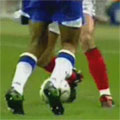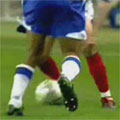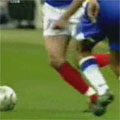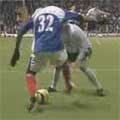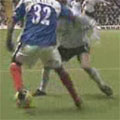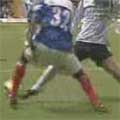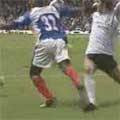Soccer Dribbling Moves
Dribbling in soccer is done with the inside, outside and the sole of the foot.
Decent players can run with the ball and change direction while keeping it under control.
To accelerate, don't kick the ball farther away from your body.
Instead, move your feet quicker and push the ball more frequently.
It's important to be able to dribble while looking around the field at the same time.
When you have the ball and there is open space in front of you, take it!
By dribbling into space, you are drawing defenders out of position and opening up the game.
Dribbling across the field often creates new passing options so always keep your head up while you dribble.
When dribbling, you should always be the person with the most immediate access to the ball.
If you don't keep the ball close to your body, you will lose it.
Be patient when confronted by defenders.
If the defender is jockeying, use feints and tricks to get him off balance.
Never put your head down and pray that a move will work.
Instead, react to the defender by looking at his stance and trying to find weaknesses in his footing.
Contents
Dribbling moves
Matthews move
The Matthews is a very effective move, especially when the defender is jockeying.
You start by pushing the ball to the inside using your instep and then you immediately accelerate in the opposite direction.
The trick is to switch direction as quickly as possible so the defender doesn’t have time to react.
Stepover move
In this encounter from World Cup 1966, Pele is approached by a defender. He performs a stepover feint that fools the defender to shift to one side. Pele takes note of this and runs in the opposite direction.
Rivelino move
This is of the favorite moves of the Brazilian midfielder Roberto Rivelino.
The Rivelino move is similar to a stepover,
except that the same foot is used to push the ball outside, around the defender.
For the move to work, you really have to make the stepover look convincing.
Cut move
This move involves pushing the ball one way and then immediately cutting in the opposite direction.
Puskás move
Commonly known as the V-move, this trick was often used by the legendary Hungarian attacker Ferenc Puskás.
The move works best when the defender is nearby.
Start by putting your foot on top of the ball at which point the defender will usually come in for a tackle.
Using the same foot, pull the ball back then push it sideways and accelerate.
Some players like to fake a pass before performing the V-move.
Scissors feint
The Scissors feint involves moving your foot around the ball and planting it to the side.
It’s important to accelerate right after performing the feint.
Also, make sure to practice the scissors while the ball is moving.
Kick feint
This is a subtle but useful move.
Usually, the defender needs to be coming in at speed in order for the feint to work.
Cruyff move
This was the trademark move of the Dutch legend Johan Cruyff.
Notice how the upper body is used by extending the arm.
This is crucial in misleading the opponent.
The Roulette
This is one of Zinedine Zidane's favorite moves.
First, let the ball roll away from you body.
When the defender commits, pull the ball back with the sole of your foot and spin around.
The Roulette can sometimes be performed as you are receiving the ball.
Lunge feint
In this example, Ronaldo is on a breakaway against the goalkeeper. Ronaldo performs a couple of lunges that throw the keeper off balance. Usually, you need sufficient space between yourself and the defender for the lunge move.
Nutmeg move
This move is sometimes called Panna.
The key here is to observe the defender, especially if he is facing you straight on.
If he hasn't angled his body correctly, he may be susceptible to a nutmeg.
Okocha move
The move is one of Okocha's favorites and is composed of two steps.
First, Okocha rolls the ball laterally, across his body.
Next, he steps over the ball and accelerates.
Combining these two moves together can easily catch defenders off guard.
Roll and scissors move
This is a combination of two simple moves. Zidane rolls the ball laterally to his left, performs a scissors feint and then accelerates right. As you can see in the last couple of frames, the defender is fooled to shift in the direction in which the ball was originally rolling.
Elastico move
The Elastico is a two-part move, sometimes used by Ronaldinho. First, Ronaldinho pushes the ball with his instep and then quickly cuts it using the same foot. It's important to keep your foot close to the ball, when transitioning between the two parts.
Scotch move
The key to the Scotch move is angling your body. You have to turn your hips 45 degrees relative to the direction where you want to go. Otherwise, the ball will hit your supporting leg or fly off to the side.
The Sleeper
This move works well in close quarters, so it's more common with indoor soccer.
Slide the ball forward with your inside,
then quickly stop it by placing the sole of your foot on top.
Sombrero flick
Nigerian midfielder Okocha has a tremendous repertoire of tricks.
In this particular case, he is approached by a defender from the right.
Okocha notices that the defender is coming in at speed.
He flicks the ball up and leaves the defender running past him.
Rainbow flick
The Rainbow flick look easy in the example above, but it's not a move that you're going to see very often!
Flicking the ball over the defender using both feet requires a lot of skill and is difficult to perform at full speed.
There should be space behind the defender too where you can safely settle the ball.
Dribbling drills
Dribbling around cones is a great exercise because
it forces you to do a lot of repetitions quickly.
Setup your cones in a line approximately a meter or two apart.
Start at one end and slalom through the cones as quickly as you can.
Make sure to practice with both feet!
Winning in 1v1
Taking on defenders is risky and shouldn't be attempted unless you are trying produce a shoot or when you are out on the flanks.
Near the sideline, dribbling can work wonders and it's not as important when you lose possession there.
Beating opponents in 1v1 requires composure and good reflexes.
Most importantly, you have to watch and react to the defender.
As you approach an opponent, lock your eyes on his feet and be prepared to react to his tackle.
Keep your center of gravity low by leaning forward and bending the knees.
Don't try to beat your opponent right away unless he is out of balance or flatfooted.
Instead, stay on your toes and be prepared to move laterally in either direction.
Look at these visual examples:
In both situations, the defender starts out with balanced footing.
But in the second frame he raises one foot off the ground.
If he raises his foot that is farther away from the ball, you move out.
If he raises his foot that is nearer to the ball, you move in.
The basic idea is to dribble in direction of the defender's supporting foot.
Some opponents may be very patient. If the defender is jockeying and refuses to bite,
you can throw him off balance using feints. By performing feints and tricks,
you may be able to get your opponent to freeze up or lean to one side.
Be prepared to react and move quickly, because he may be off balance for no longer than a split second.
